Did you know that tomatoes are the most widely grown vegetable in home gardens across the United States? With their vibrant colors and delicious flavors, tomatoes have become a staple in kitchens and salads nationwide. However, to achieve the best growth and harvest, tomatoes require the right nourishment. Investing in the proper tomato feed is essential for healthy plants and bountiful yields.
Key Takeaways:
- Choose the right tomato variety for optimal growth based on your climate and growing conditions.
- Understand the nutrient needs of tomatoes, including phosphorus, calcium, and nitrogen.
- Prepare the soil by adding compost and organic fertilizer before planting tomatoes.
- Transplant tomato seedlings carefully, using aspirin spray to boost their immunity.
- Consider different types of tomato fertilizer, such as organic, liquid, or granular options.
Choosing the Right Tomato Variety for Optimal Growth
To maximize tomato growth, it’s important to choose a tomato variety that suits your climate and growing conditions. The right tomato variety can make a significant difference in the success of your garden. Whether you are a beginner or an experienced gardener, selecting the right tomato variety requires careful consideration of various factors.
First and foremost, consider the tomato maturity time. The maturity time refers to the number of days it takes for the tomato to reach its full size and ripen. It’s essential to choose a variety that aligns with your local frost-free window. This ensures that you can enjoy a bountiful harvest before the cold weather sets in.
There are two main types of tomato varieties based on their growth habit: determinate and indeterminate tomatoes. Determinate tomatoes are compact and bushy, reaching a predetermined height, usually around 2 to 3 feet. These varieties are well-suited for smaller gardens or containers. Indeterminate tomatoes, on the other hand, are vining and continue to grow and produce tomatoes throughout the season. They can grow to be quite large, often requiring staking or trellising for support.
“Shorter growing seasons may benefit from smaller, determinate tomatoes, while longer seasons can accommodate larger, indeterminate beefsteak types.” These determinate tomatoes mature earlier, making them suitable for regions with shorter growing seasons. Indeterminate tomatoes, on the other hand, have a longer growing season and can produce a continuous harvest of tomatoes.
Hybrid tomatoes are also worth considering. These varieties are created by crossbreeding different tomato varieties to incorporate desirable traits, such as disease resistance. Hybrid tomatoes offer improved disease resistance and can withstand challenging environmental conditions better. They are often a great choice for gardeners who want to reduce the risks of diseases and pests.
Lastly, heirloom tomatoes are another option for tomato enthusiasts. Heirloom tomatoes are open-pollinated varieties that have been passed down through generations for their exceptional flavor and unique characteristics. They come in a wide range of colors and shapes and are often favored by those seeking a diverse tomato selection.
Tomato Variety Comparison
| Tomato Variety | Maturity Time | Plant Type | Suitable Growing Conditions |
|---|---|---|---|
| Determinate Tomatoes | 60-80 days | Compact, bushy | Shorter growing seasons, smaller gardens |
| Indeterminate Tomatoes | 80-100 days | Vining, tall | Longer growing seasons, ample space |
| Hybrid Tomatoes | Varies | Varies | Challenging environmental conditions |
| Heirloom Tomatoes | Varies | Varies | Flavor diversity |
Remember, choosing the right tomato variety for your garden is a personal preference. Consider your growing conditions, available space, and desired tomato qualities before making your selection. Whichever tomato variety you choose, ensure that it receives adequate sunlight, water, and nutrition to achieve optimal growth and a fruitful harvest.
Understanding Tomato’s Nutrient Needs
Tomatoes are heavy feeders and require adequate nutrition to flourish. To ensure the healthy growth of tomato plants, it is essential to understand their specific nutrient requirements.
“Proper nutrition is the key to tall, healthy plants with plenty of flowers and fruits.”
The key nutrients that tomatoes need to thrive are:
- Phosphorus: Phosphorus is crucial for supporting flower and fruit growth in tomato plants. It plays a vital role in energy transfer and overall plant development.
- Calcium: Calcium is essential for preventing a common tomato plant disorder called blossom end rot. Adequate calcium levels ensure the healthy development of fruit.
- Nitrogen: Nitrogen is important for overall plant growth and leaf production. However, excessive nitrogen can result in a plant with lush foliage but limited flower and fruit formation.
It’s important to provide these essential nutrients from the start to promote optimal growth and productivity in tomato plants.
Tomato Nutrient Needs
| Nutrient | Function | Symptoms of Deficiency |
|---|---|---|
| Phosphorus | Promotes flower and fruit growth | Poor fruit development, stunted growth |
| Calcium | Prevents blossom end rot | Soft, rotting patches on the blossom end of fruit |
| Nitrogen | Supports overall plant growth | Yellowing leaves, poor growth |
Preparing the Soil for Tomato Planting
Before planting tomatoes, it’s crucial to prepare the soil. Proper soil preparation sets the foundation for healthy plant growth and robust tomato production. Here are the key steps to follow:
- Add Well-Aged Compost: Start by adding a 2-3 inch layer of well-aged compost to the empty bed. Compost enriches the soil with essential nutrients, improves its structure, and enhances moisture retention. Spread the compost evenly over the surface of the bed.
- Apply Organic All-Purpose Fertilizer: Next, apply a granular, organic, all-purpose fertilizer with a balanced 4-4-4 blend. This type of fertilizer provides a mix of nitrogen, phosphorus, and potassium, vital for healthy plant growth and fruit development. The all-purpose blend ensures that your tomato plants receive a well-rounded nutrient supply.
- Incorporate the Compost and Fertilizer: Use a garden fork or a tiller to lightly incorporate the compost and fertilizer into the soil. Avoid overmixing or disturbing the soil structure excessively. This helps to distribute the compost and fertilizer more evenly, ensuring that the nutrients are accessible to the plant roots.
- Water Well: After incorporating the compost and fertilizer, thoroughly water the bed to ensure that the nutrients penetrate the soil. Adequate moisture is essential for the compost and fertilizer to break down and become available to the plant roots.
- Allow the Bed to Settle: Let the bed settle for a day or two before planting your tomato seedlings. This allows the compost and fertilizer to integrate with the soil and ensures a stable growing environment for your plants.
By following these steps, you’ll create an optimal soil environment for your tomato plants, setting them up for success throughout the growing season.
Example Table: Comparison of Organic and All-Purpose Fertilizers
| Fertilizer | Ingredients | Nutrient Ratio | Advantages |
|---|---|---|---|
| Organic Fertilizer | Compost, manure, bone meal, etc. | Variable, based on ingredients |
|
| All-Purpose Fertilizer | Nitrogen, phosphorus, potassium | 4-4-4 |
|
Transplanting Tomato Seedlings
Transplanting tomato seedlings is a critical step in ensuring their successful growth and development. When the seedlings are about a foot tall and have been hardened off, they are ready to be transplanted into the garden. Transplanting at the right time and with proper care will give your tomato plants a strong start.
Before transplanting, it’s recommended to give the seedlings an aspirin spray to boost their immunity and help prevent diseases. This can be done by dissolving one aspirin tablet in a gallon of water and spraying the mixture on the seedlings. Aspirin has been found to have beneficial effects on plant health and can improve their resistance to stress.
When choosing the best time to transplant, aim for a cloudy day or the late afternoon to minimize stress on the plants. The reduced sunlight and cooler temperatures will help the seedlings adjust to their new environment more easily.
When digging the hole for transplanting, make sure it is deep enough to bury the stem up to its lowest set of leaves. This encourages the growth of additional roots along the buried stem, resulting in a stronger and more stable plant. A good rule of thumb is to dig a hole that is about a foot deep.
Hardening Off Tomato Seedlings
Hardening off is an important process that prepares seedlings for the transition from a protected environment to the outdoor conditions. It helps them adapt to changes in temperature, sun exposure, and wind. To harden off your tomato seedlings, follow these steps:
- Start by placing the seedlings outdoors in a sheltered area for a few hours each day, gradually increasing the time over the course of a week.
- Expose the seedlings to direct sunlight for short periods, gradually increasing the duration of exposure.
- Gradually expose the seedlings to outdoor temperatures, starting with mild days and progressing to cooler nights.
- Protect the seedlings from heavy rain, strong winds, and sudden temperature drops during the hardening off period.
By following the hardening off process, your tomato seedlings will become better acclimated to the outdoor conditions and will be more resilient to the challenges they may face in the garden.
Enhancing Growth with Fish Heads
For enhanced growth and productivity, consider using a secret ingredient – fish heads! Fish heads are rich in nitrogen, phosphorus, and trace minerals that are beneficial for tomato plants. They can be buried in the planting hole alongside the seedling or placed in the planting area prior to transplanting.
Not only do fish heads provide essential nutrients, but they also attract beneficial soil organisms and encourage microbial activity. This can result in improved soil fertility and overall plant health. Embrace this natural and sustainable method to give your tomato plants an extra boost!
| Transplanting Tips | Benefits |
|---|---|
| Transplant seedlings when they are about a foot tall | Allows for strong root development and better plant establishment |
| Use an aspirin spray before transplanting | Boosts immunity and helps prevent diseases |
| Choose a cloudy day or late afternoon for transplanting | Reduces stress on the plants |
| Bury the stem up to its lowest set of leaves | Promotes additional root growth and increases plant stability |
| Consider using fish heads as a natural fertilizer | Provides essential nutrients and enhances soil fertility |
Tomato Fertilizer Guide
Consistent fertilization is essential for the optimal growth of tomato plants. The right tomato fertilizer should contain the three main nutrients: nitrogen, phosphorus, and potassium. These nutrients play crucial roles in the development of healthy tomato plants and abundant fruit production.
When it comes to choosing a tomato fertilizer, personal preference and the chosen application method are important factors to consider. There are different types of fertilizers available, each with its own advantages.
Types of Tomato Fertilizers
1. Organic Fertilizers: Organic fertilizers are derived from natural sources and are favorable for those who prefer an eco-friendly approach to gardening. Many organic options contain a balanced mix of nitrogen, phosphorus, and potassium, making them ideal for promoting overall plant health.
2. Liquid Fertilizers: Liquid fertilizers are convenient to use and are quickly absorbed by the plants’ roots. They can be applied directly to the soil or as a foliar spray, providing a quick nutrient boost to your tomato plants.
3. Granular Fertilizers: Granular fertilizers are slow-release options that provide a steady supply of nutrients over time. They are applied to the soil and gradually break down, ensuring a continuous nutrient supply for your tomato plants.
Aside from commercially available fertilizers, there are also homemade options that can be mixed into the soil to enrich it further:
- Compost: Compost is a valuable source of organic matter and nutrients. Adding compost to your soil helps improve its structure and provides nutrients for healthy tomato growth.
- Manure: Well-aged animal manure, such as cow or chicken manure, can be mixed into the soil to supply essential nutrients and improve soil fertility.
- Bone Meal: Bone meal is rich in phosphorus, an essential nutrient for flowering and fruiting. Incorporating bone meal into the soil helps promote robust tomato plants and abundant harvests.
By choosing the right tomato fertilizer and following a consistent fertilization routine, you can ensure that your tomato plants receive the necessary nutrients for healthy growth and high-quality fruit production.
Comparison of Tomato Fertilizer Types
| Fertilizer Type | Advantages |
|---|---|
| Organic Fertilizers | Environmentally-friendly, long-lasting nutrient supply, promotes overall plant health |
| Liquid Fertilizers | Quickly absorbed, provides an immediate nutrient boost, convenient application |
| Granular Fertilizers | Slow-release, continuous nutrient supply, easy to apply |
Timing and Frequency of Tomato Fertilization
As tomato plants go through different stages of growth, their nutrient requirements also change. Proper timing and frequency of fertilization are essential for ensuring healthy tomato plants and maximizing fruit production.
Tomato Growth Stages
Understanding the different growth stages of tomato plants is key to determining when and how often to fertilize. The main stages of tomato growth are:
- Transplanting: After transplanting your tomato seedlings into the garden, it’s important to wait for a few weeks before applying fertilizer. This allows the plants to establish their root systems.
- Vegetative Growth: Once the plants have established, they enter a phase of vigorous vegetative growth. This is when they benefit from nitrogen-rich fertilizers to promote healthy foliage development.
- Flowering: As the tomato plants begin to flower, they require higher levels of potassium. Potassium helps in the formation of strong flower clusters and promotes fruit development.
- Fruit Production: During this stage, the plants need a balance of nutrients to support the development of high-quality fruits. Phosphorus and potassium are particularly important for fruit formation and ripening.
It’s crucial to closely monitor the growth of your tomato plants and adjust your fertilization schedule accordingly to meet their changing nutritional needs.
Timing and Frequency of Fertilization
When it comes to tomato fertilization, it’s important to follow the instructions provided by the manufacturer for the specific fertilizer you are using. These instructions will guide you on the quantity and frequency of application for optimal results.
As a general guideline, it’s recommended to fertilize tomato plants every two weeks during the growing season. This regular schedule ensures a steady supply of nutrients to support healthy growth and fruit production.
| Tomato Growth Stage | Fertilization |
|---|---|
| Transplanting | No fertilizer immediately after transplanting, wait a few weeks |
| Vegetative Growth | Apply nitrogen-rich fertilizer three to four weeks after transplanting |
| Flowering | Increase potassium levels to support fruit development |
| Fruit Production | Maintain a balanced fertilization regimen with phosphorus and potassium |
Remember to monitor your plants closely for any signs of nutrient deficiencies or excesses, such as yellowing leaves or stunted growth. Adjust your fertilization schedule or switch to a different fertilizer if necessary.
Choosing the Right Tomato Fertilizer
When it comes to selecting the best tomato fertilizer, there are several options available that cater to different needs and preferences. Let’s explore some popular choices:
Tomato-Tone Organic Fertilizer
If you prefer an all-natural approach, tomato-tone organic fertilizer is a fantastic option. Enriched with beneficial microbes, this fertilizer promotes healthy soil and supports sustainable plant growth. The organic formula provides long-lasting nourishment for your tomato plants, ensuring robust foliage, vibrant blooms, and bountiful fruit production.
Miracle-Gro Tomato Plant Food
If you’re looking for instant results, Miracle-Gro Tomato Plant Food is a dissolvable formula that delivers rapid nutrient absorption. Designed specifically for tomatoes, this fertilizer is packed with essential nutrients to maximize plant growth and development. With its water-soluble composition, your tomato plants can quickly absorb the nutrients, resulting in vigorous growth and a fruitful harvest.
Dr. Earth Organic Fertilizer
Dr. Earth offers an exceptional organic fertilizer suitable not only for tomatoes but also for other vegetables. This fertilizer is enriched with a blend of beneficial microbes and organic nutrients, providing a balanced diet for your plants. The slow-release formula ensures a steady supply of nutrients, allowing for long-term nourishment and sustainable growth.
When choosing the best tomato fertilizer for your garden, consider the specific needs of your plants. Pay attention to the NPK ratios (Nitrogen, Phosphorus, Potassium) and additional ingredients listed on the packaging. A well-balanced fertilizer will provide the necessary nutrients to support healthy foliage, strong roots, and abundant fruit production.
“Choosing the right tomato fertilizer is crucial for the overall health and productivity of your plants. With the right blend of nutrients, you can ensure your tomato plants thrive and yield a bountiful harvest.” – Gardening Expert
Now that you have a better understanding of different tomato fertilizers, you can make an informed decision based on your gardening goals and preferences.
Understanding Tomato Fertilizer Composition and Soil Needs
When it comes to providing proper nutrition for tomato plants, understanding the composition of tomato fertilizer and the needs of the soil is crucial. Tomato plants require a balanced combination of macro and microelements to thrive and produce a bountiful harvest. It’s important to consider the essential nutrients, such as nitrogen, phosphorus, potassium, calcium, magnesium, iron, boron, zinc, copper, and molybdenum, when selecting a suitable tomato fertilizer.
Different soils have varying nutrient balances and pH levels, which affect the availability of nutrients to the plants. Conducting a soil test provides valuable insights into the specific needs of your soil and helps determine the ideal fertilizer formulation. Whether your soil requires more nitrogen, phosphorus, or potassium, understanding its composition ensures that you provide the necessary nutrients in the right proportions.
Additionally, soil pH plays a significant role in nutrient availability and uptake by plants. Tomato plants prefer slightly acidic soil with a pH level between 6.0 and 6.8. If the soil pH is outside this range, certain nutrients may become locked in the soil, leading to nutrient deficiencies or toxicities. Monitoring and adjusting the soil pH, if necessary, can improve nutrient availability and promote healthy plant growth.
Organic Fertilizers for Healthy Soil and Plants
“Using organic fertilizers derived from animal manure, compost, and other natural sources is highly beneficial for achieving healthy soil and promoting plant growth.”
Organic fertilizers enrich the soil with essential nutrients while also improving its structure and fertility. They release nutrients slowly over time, providing a consistent supply for the plants and reducing the risk of nutrient imbalances or leaching. Animal manure, such as well-aged composted cow, horse, or chicken manure, is a rich source of organic matter and nutrients.
Compost, created by decomposing organic waste materials, improves soil structure, enhances water retention, and promotes microbial activity. Adding compost to the soil helps maintain nutrient levels and sustains beneficial microorganisms that support plant health.
In addition to animal manure and compost, other organic options include bone meal, fish emulsion, kelp meal, and blood meal. These natural sources of nutrients provide a well-rounded fertilizer composition and contribute to the overall health of the soil and plants.
| Nutrient | Sources |
|---|---|
| Nitrogen | Animal manure, fish emulsion, blood meal |
| Phosphorus | Bone meal, rock phosphate |
| Potassium | Kelp meal, wood ashes |
| Calcium | Eggshells, gypsum |
By incorporating organic fertilizers into your tomato fertilization regimen, you promote sustainable gardening practices and cultivate a healthy and thriving garden.
Homemade Tomato Fertilizer Options
Creating your own homemade tomato fertilizer is an affordable and eco-friendly way to provide essential nutrients to your tomato plants. By using easily available ingredients, you can tailor the fertilizer to meet the specific needs of your soil and promote healthy plant growth.
There are several organic materials that you can combine to create a nutrient-rich homemade tomato fertilizer:
- Compost: Compost is a valuable source of organic matter and nutrients. It enhances soil structure, improves moisture retention, and promotes nutrient availability for the plants.
- Alfalfa Meal: Alfalfa meal is rich in nitrogen and other essential nutrients. It helps improve overall plant growth and promotes the development of strong, healthy tomato plants.
- Bone Meal: Bone meal is an excellent source of phosphorus, which is essential for fruit development and root growth. It also contains calcium, which helps prevent blossom end rot.
- Eggshells: Crushed eggshells add calcium to the soil, preventing calcium deficiency in tomato plants and reducing the risk of blossom end rot.
- Wood Ashes: Wood ashes are a good source of potassium and other trace minerals. They help promote fruit development and improve overall plant health.
- Kelp Meal: Kelp meal is rich in micronutrients, including magnesium, boron, and zinc. It boosts plant growth, enhances disease resistance, and improves soil fertility.
To create your homemade tomato fertilizer, combine these ingredients in the desired quantities, ensuring a balanced nutrient mix. You can experiment with different ratios and observe the results to find the most effective combination for your plants.
Remember, homemade tomato fertilizers are best used in conjunction with other organic gardening practices, such as proper watering, mulching, and pest control. By taking a holistic approach to tomato plant care, you can maximize growth, yield, and overall plant health.
Benefits of Homemade Tomato Fertilizers
Using homemade tomato fertilizers offers several advantages:
“Homemade tomato fertilizers provide a cost-effective and sustainable solution to nourish your tomato plants. By utilizing organic materials and tailoring the fertilizer to your soil’s needs, you can provide essential nutrients while minimizing environmental impact.”
By understanding and harnessing the power of homemade tomato fertilizers, you can enjoy a thriving tomato garden while minimizing the use of synthetic fertilizers.
| Fertilizer Ingredient | Main Nutrients | Benefits |
|---|---|---|
| Compost | Organic matter, macronutrients, micronutrients | Improves soil structure, enhances nutrient availability |
| Alfalfa Meal | Nitrogen, potassium, phosphorus, trace minerals | Promotes overall plant growth, enhances root development |
| Bone Meal | Phosphorus, calcium | Supports fruit development, prevents blossom end rot |
| Eggshells | Calcium | Prevents calcium deficiency, reduces blossom end rot |
| Wood Ashes | Potassium, trace minerals | Promotes fruit development, improves plant health |
| Kelp Meal | Micronutrients, growth hormones | Enhances disease resistance, improves soil fertility |
Conclusion
Successfully cultivating tomatoes requires providing them with the proper nutrition and care. By following tomato feed tips, selecting the right tomato variety, preparing the soil, and using effective tomato fertilizer, you can maximize your tomato plant’s growth and ensure a bountiful harvest.
Understanding the nutrient needs of your tomato plants is crucial. Make sure to choose fertilizers that contain the necessary elements, such as nitrogen, phosphorus, and potassium, to support their growth. Experiment with both commercial options and homemade mixtures to find the most effective feeding regimen for your plants.
Remember that proper care and nutrition are key to the success of your tomato cultivation. By providing your plants with balanced tomato feed, you can promote their overall health and productivity. Enjoy the satisfaction of growing your own delicious tomatoes with the knowledge that you have done everything possible to ensure their success.

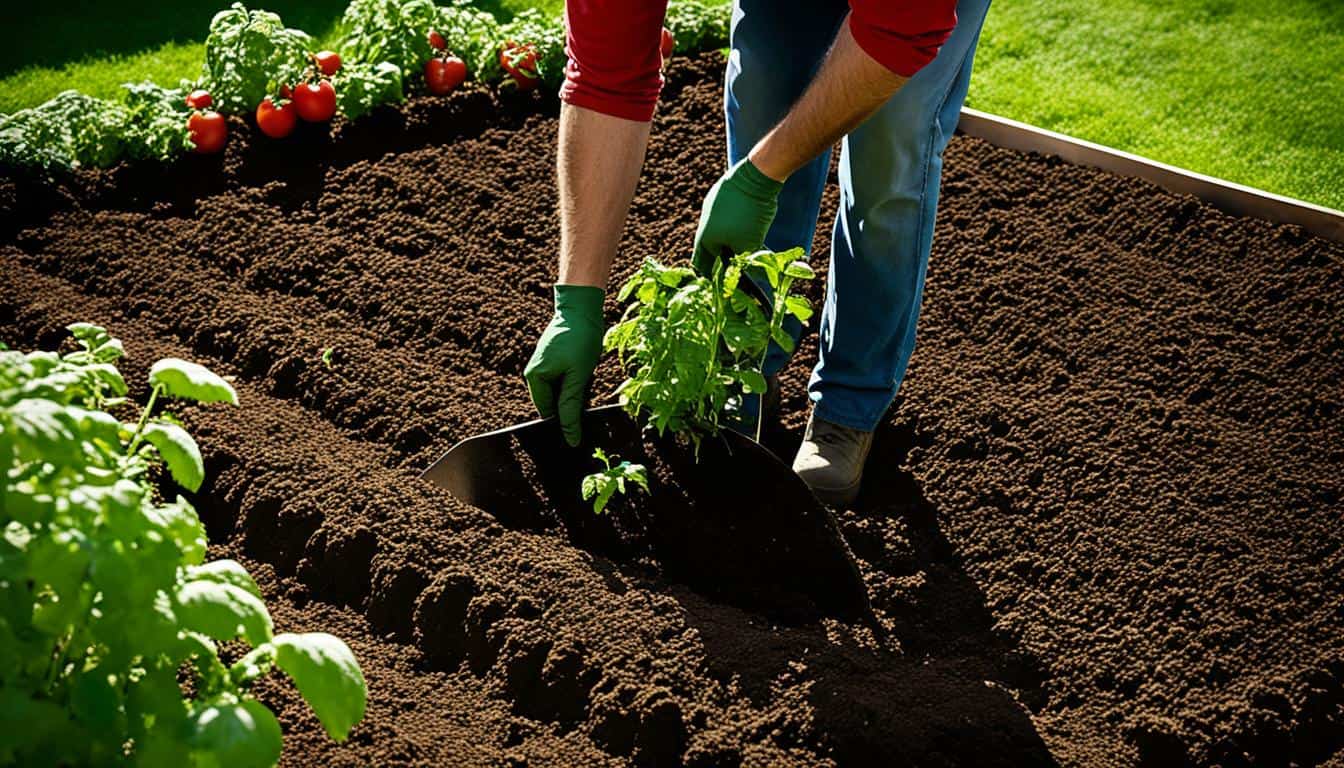
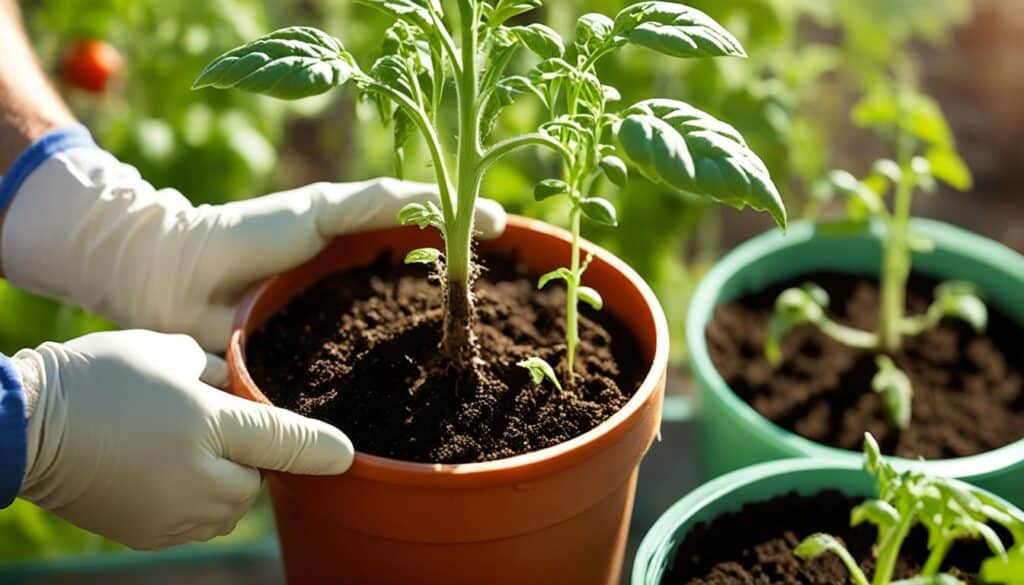
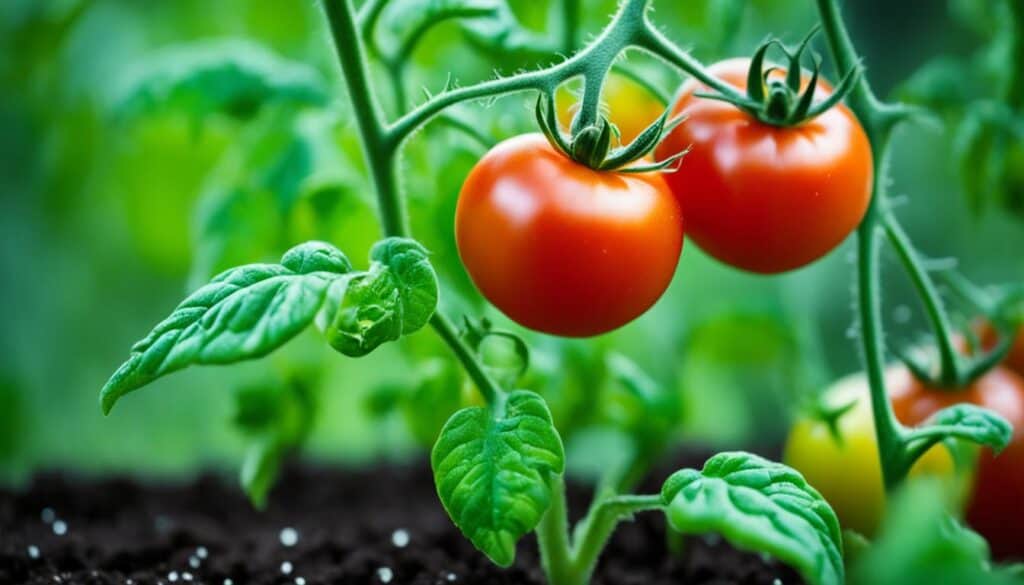
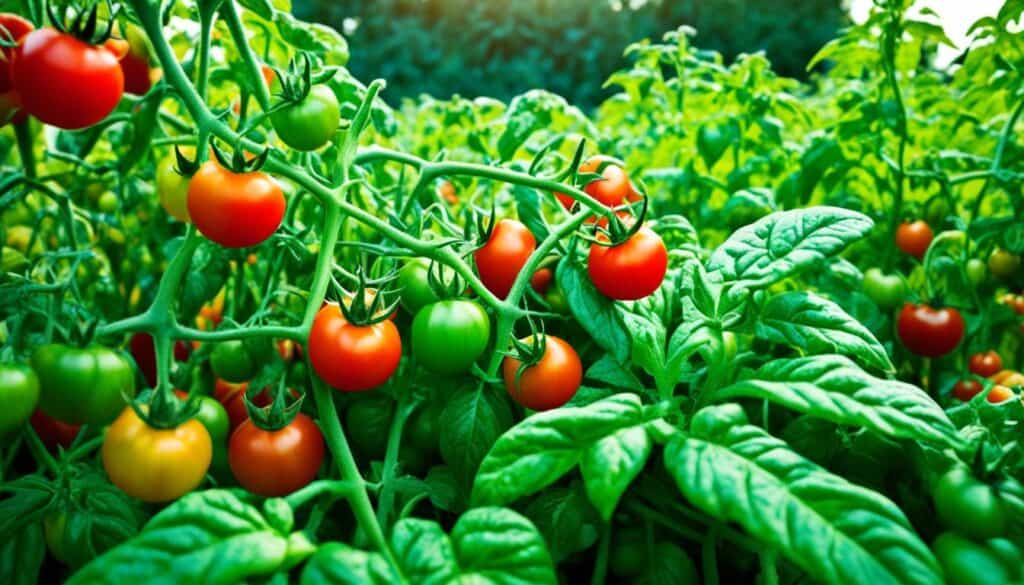
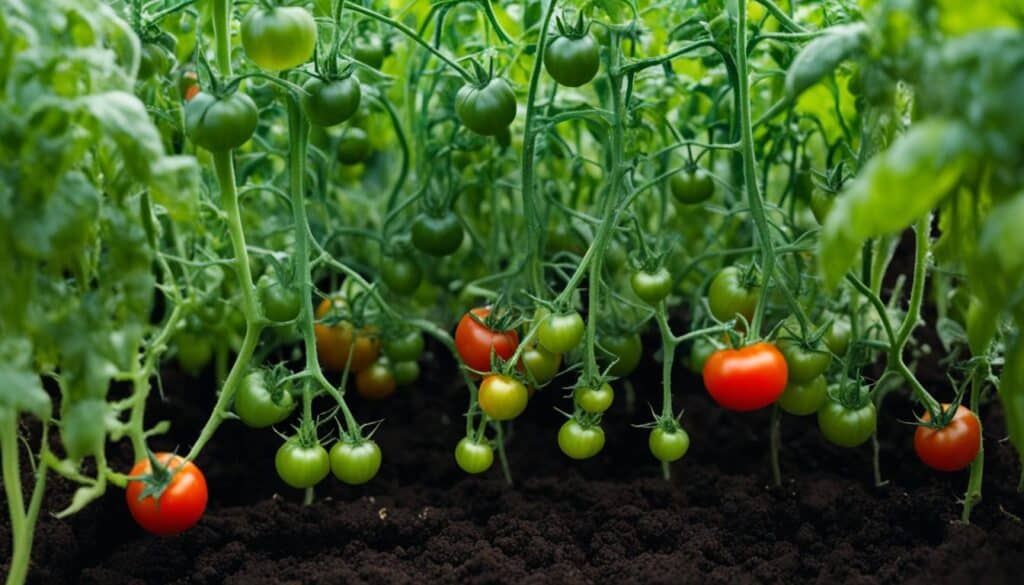
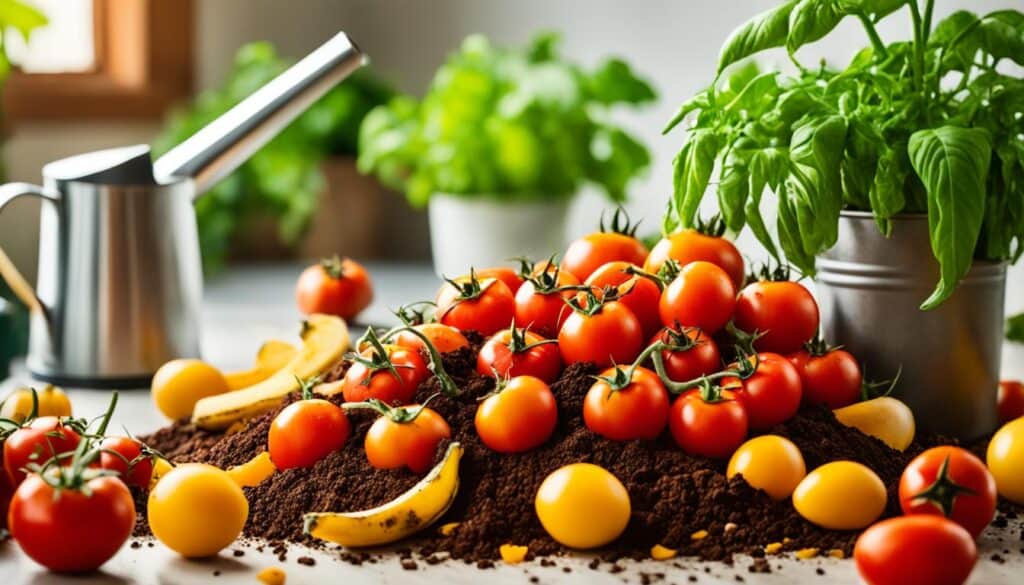

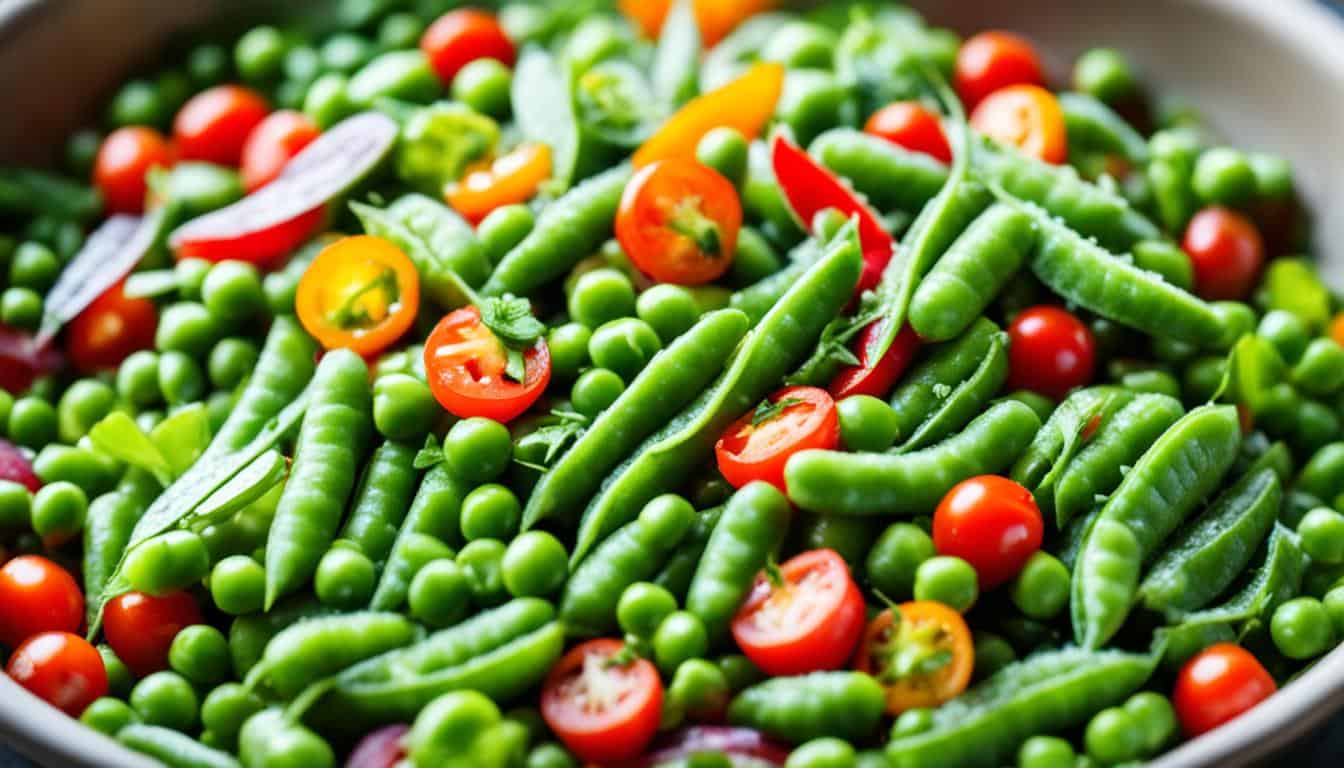
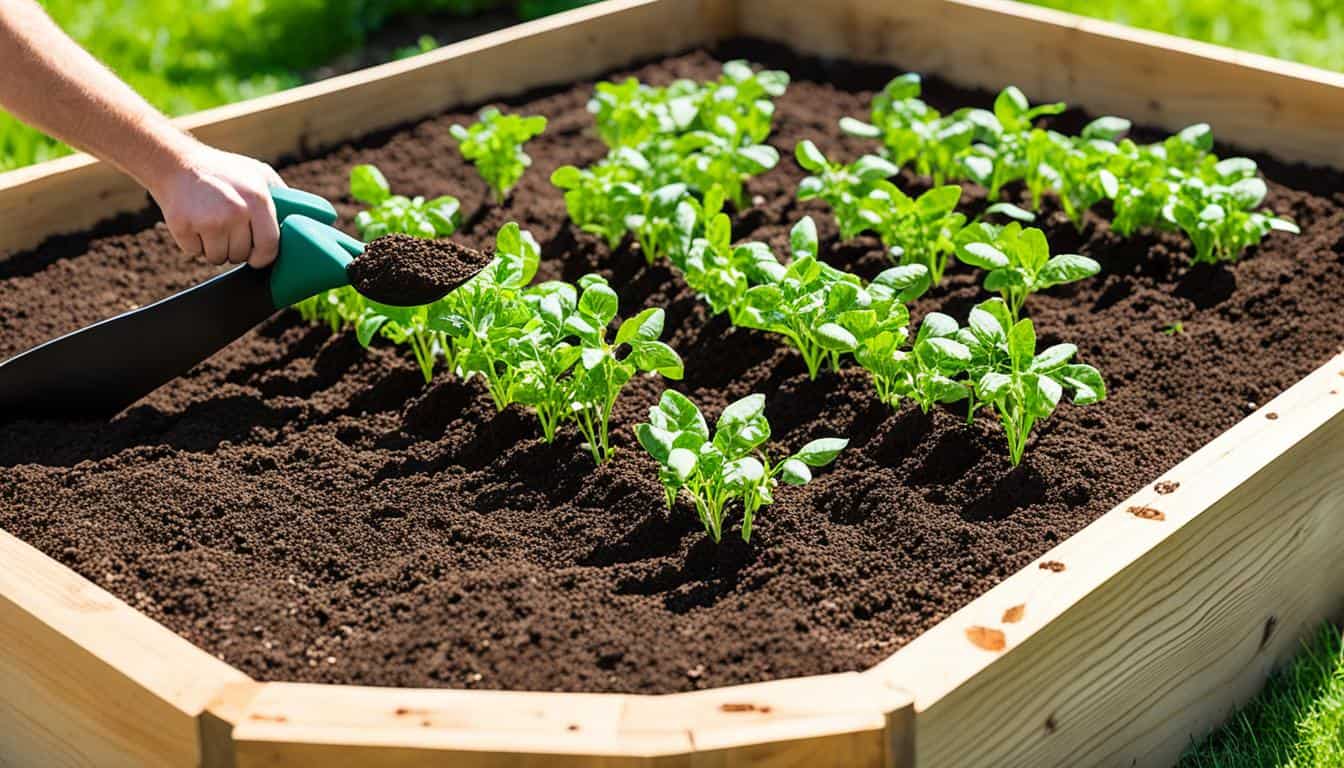
Leave a Reply